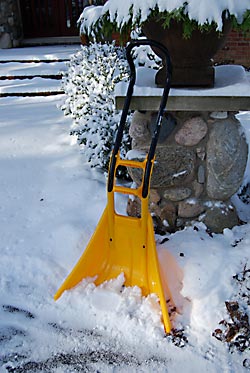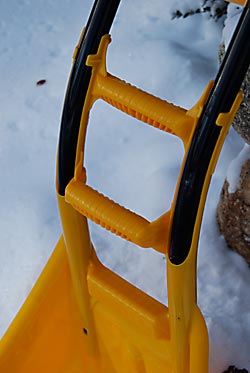We received our first significant snowfall of the year (5 inches or so) and it gave me a chance to use a new snow moving tool: the SnoBoss, made by True Temper.


The lightweight SnoBoss has a large, curved handle that is big enough to put 2 hands on so you can comfortably push show. The blade is slightly wider than a shovel. Unlike a shovel, the scoop area on the SnoBoss is large and can hold much more snow. This is especially helpful, as it eliminates the skinny lines of overflow snow that a shovel usually leaves behind. When you are done pushing a line of snow, you have 2 choices: lift and toss it, or push it away. Believe it or not, lifting and tossing a full load of snow is not a huge strain. Why? The SnoBoss has well-positioned handles (there are 2 actually, choose whichever one is the right fit for you) that allow you to stand next to the load, making it easier to lift that a traditional shovel, where you stand behind the load.
If lifting is not possible, you can simply push the snow into a pile or snowbank. What if it gets too big? You can use the SnoBoss to actually move the pile. Not all at once, of course. Push the SnoBoss up to the pile and simply move the handle up or down, which changes the angle of the blade, and thus, the amount of the pile you tackle. For example, on a 30-inch high pile, you might bite off the top 10 inches and push that away toward the back of the pile. Then push another 10 inches to the back, and so on.

I have always been “green” when it comes to snow clearing—I use the old-fashioned method: elbow grease (an iPod comes in handy too). No snow blower for me; I like the exercise and fresh air. That said, the SnoBoss helps make the job easier.
